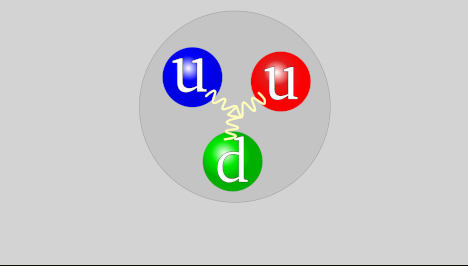- Series:Astronomy, Transcript English
Genesis 1:1-2
“In the beginning God created the heaven and the earth. And the earth was without form, and void; and darkness was upon the face of the deep. And the Spirit of God moved upon the face of the waters.”
 In the fourth century BC, the Greek philosopher Democritus proposed that matter was made of small particles. He assumed that, if you kept cutting material up, you would eventually get to a particle which was uncuttable – the smallest possible particle. The Greek for uncuttable is atomos – hence, the idea of atoms was born.
In the fourth century BC, the Greek philosopher Democritus proposed that matter was made of small particles. He assumed that, if you kept cutting material up, you would eventually get to a particle which was uncuttable – the smallest possible particle. The Greek for uncuttable is atomos – hence, the idea of atoms was born.
In the 19th Century, scientists began to suspect that atoms were made of smaller particles. In 1913, Niels Bohr proposed his atomic model of tiny electrons orbiting a nucleus comprised of larger particles called protons and neutrons – collectively known as hadrons.
In the 1960s, scientists began to suspect that hadrons were composed of smaller particles. These particles became known as quarks. Instead of positive and negative bipolar charges, quarks have three-way attractions, which are labeled as color charges of red, blue, and green, even though these colors are not real. Bombardment of hadrons by electrons has caused electrons to be deflected in a manner which suggests the existence of quarks.
All of this seemed to help us understand the nature of matter at the tiny quantum level. But now, some physicists are suggesting that the effect previously ascribed to quarks may just be the observed consequences of quantum weak interactions. In other words, quarks may not even exist.
Whatever resolution physicists find to these strange phenomena, it is certainly the case that these strange designs are consistent with the fact that God created every detail of this wonderful universe, from the smallest to the largest objects.
Prayer: Thank You, Lord, for scientists who spend their time researching Your universe. Even though many of them do not acknowledge Your hand, we give You praise for the amazing design that they find. Amen.
Author: Paul F. Taylor
Ref: Why matter’s most basic building blocks may not exist, < https://www.newscientist.com/article/mg24332500-900-what-the-quark-why-matters-most-basic-building-blocks-may-not-exist/ >, accessed 9/30/2019. Image: CC BY-SA 4.0 International.
© 2020 Creation Moments. All rights reserved
